
How it works:
Each day, Mike Caro deals a hold ’em starting hand, which is displayed on the Poker1.com home page.
When you click the link, you come to a page (like this one) that provides the statistics for that category of hand.
Then we ante $1 million and deal a five-player showdown.
IMPORTANT: This Poker1.com home-page feature is experimental. I haven’t decided whether it will appear daily after P1 officially opens, whether it will appear occasionally, or whether it will be abandoned. The decision will depend largely on the number of visits it receives.
Hands are posted soon after being dealt. Please let me know about any glitches. — Mike Caro
→ Jump down to today’s $5 million showdown
Anatomy of today’s hold ’em hand
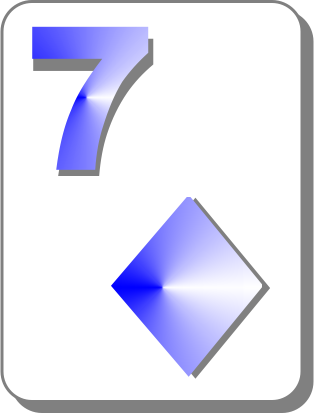

Category1: 7-6 of mixed suits
Expected win rate2 vs. a random hand (heads up): 42% (50% is average)
Expected win rate2 vs. eight random hands (nine-handed): 10% (11.11% is average)
Odds against being dealt a hand in this category3: 109.5 to 1
MCU4 ranking against few opponents (limit): 135 of 169
MCU4 ranking against many opponents (limit): 126 of 169
MCU4 composite ranking (limit / all situations): 131 of 169
COPS5 units6 won or lost (limit / nine-handed): -0.23
COPS5 units6 won or lost (no-limit / nine-handed): -0.15
  Distribution chart of outcomes7 Distribution chart of outcomes7
Outcome |
(final strength) Chance of finishing |
with this outcome Chance of winning |
with this outcome Straight flush |
0.02% |
99% |
Four of a kind |
0.13% |
88% |
Full house |
2.21% |
92% |
Flush |
??.?% |
??% |
Straight |
9.06% |
93% |
Three of a kind |
4.33% |
66% |
Two pair |
22.2% |
61% |
One pair |
42.8% |
No data1 |
No pair |
17.3% |
6% |
| 1This percentage is only provided for paired starting hands, because most other hands results can be heavily skewed by the possibility of board pairs. Although similar issues affect other final hand strengths, the statistics for them usually aren’t quite as misleading. NOTES: For ties (i.e., “split pots”), chances are prorated in accordance with the share of the pot won. This chart doesn’t differentiate between results using both starting cards, one starting card, and no starting cards (“playing the board”). | ||||
|---|---|---|---|---|---|---|---|---|---|---|---|---|---|---|---|---|---|---|---|---|---|---|---|---|---|---|---|---|---|---|---|---|---|---|---|
ANATOMY NOTES:
1CATEGORY: There are 169 categories of hold ’em starting hands: 13 for pairs, 78 for non-paired cards of mixed suits, and 78 for cards of the same suit.
Categories have various numbers of members, depending on the suits and the order the cards arrive.
Therefore, there are 2,652 hold ’em starting hands that can be displayed at Poker1, assuming, as an example, that K-7 and 7-K are different. But, because order of arrival doesn’t really matter for hold ’em starting hands, there are actually only half as many combinations — 1,326 — that the 169 categories comprise.
2WIN RATE is based on computer simulation of one million deals through the showdown using Mike Caro’s Poker Probe software or another program based on the Mike Caro Poker Engine. When a hands ties, a portion of a win is credited. (Rounded to nearest percent.)
3ODDS AGAINST: There are only three possible likelihoods for any category of hand. They are 220-to-1 against a specific pair, 330.5-to-1 against any specific ranks of the same suit, and 109.5-to-1 against any specific unpaired ranks of mixed suits.
4MCU is Mike Caro University of Poker, Gaming, and Life Strategy.
The MCU rankings are for limit hold ’em. No-limit rankings are similar and often identical.
The composite category is a compromise between many and few opponents. So, it may seem strange that sometimes it can be higher or lower than both. That’s because it was determined by the actual strength relative to other composite hands, not by adding the two other rankings and dividing by two.
5COPS is Caro Online Poker Solutions — the cheating prevention system for online poker developed by Mike Caro and Bill Handy. Here’s a link to a Poker1 entry about COPS: → Go there.
6UNITS: The big blind is one unit. Therefore, +2.1 “units won or lost,” if applied to a $10 big-blind game, means the hand averages a $21 profit; -0.4 means it averages a $4 loss.
The units were calculated from a COPS database of hands played online. Some hands that are higher on the MCU rankings are misplayed and, therefore, lose more than worse hands (such as 7-2 of mixed suits) that are more often folded.
Unit information was supplied by Bill Handy, my COPS-project colleague. It is subject to revision.
7CHART OF OUTCOMES: The distribution chart lists the likelihood of outcomes from a royal flush down to no pair. The statistics reflect the final strength of the hand after all five board cards are dealt, whether both starting cards are used, one is used, or the board is played. To save time, I simulated 1,000,000 deals and, so, the statistics aren’t as precise as others found at Poker1.com that I personally calculated.
→ Jump up to anatomy of today’s hand
Today’s $5 million showdown
Now we enter today’s hold ’em hand in our imaginary $5,000,000 showdown.
You can treat it two ways: (1) as a substitute for astrology, signaling the kind of luck you can expect today; or (2) as amusement, like I do. Your choice.
Remember that — similar to real life — you only need to be lucky once in five days to break even. So, let’s ante $1 million and see what happens…
Today’s starting hands…
| ↓ Our hand ↓ | ↓ Amy ↓ | ↓ Bob ↓ | ↓ Cal ↓ | ↓ Deb ↓ |
  |
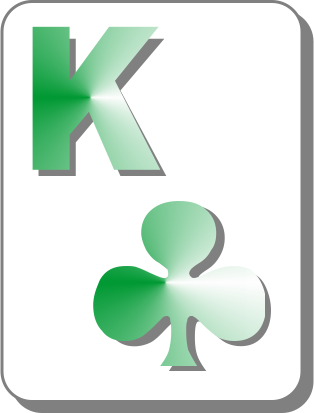 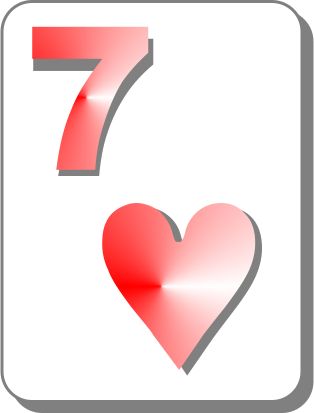 |
 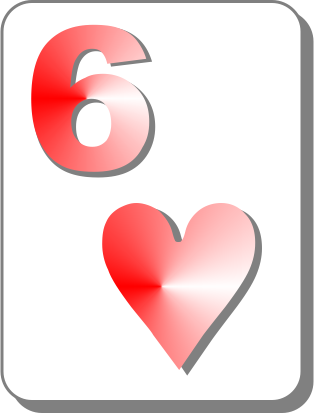 |
 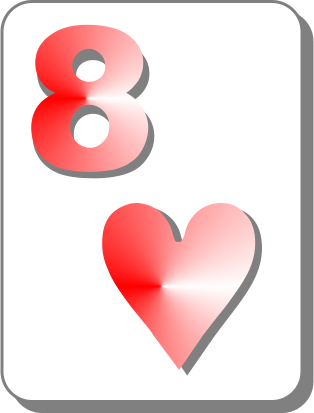 |
 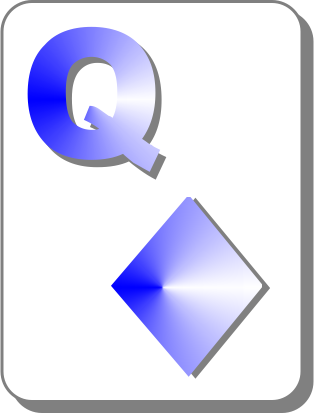 |
| 10% chance | 22% chance | 6% chance | 8% chance | 54% chance |
(Note: A 20 percent chance is average at all stages.)
Starting hand comments
This hand isn’t a disaster. But that’s because two opponents, Bob and Cal, are in worse shape than we are. Our 10 percent chance is just a little less than average (11 percent).
Deb is in outstanding shape, not just because she has a pair of queens, but also because there is only one higher ranking card held by anyone — Amy’s king. Even better for Deb, if four hearts or four diamonds are dealt on the board, her same-suited queen will win.
It’s not often that one player will start off with more than a 50 percent chance, but Deb has done it.
As for us, we’d better hope for both seven and six to pair or to make a straight. Two sixes on the board could win for us, but not two sevens, because Amy has a higher kicker. There’s no flush we can win with, because we’re high carded in both suits.
Let’s see the flop…
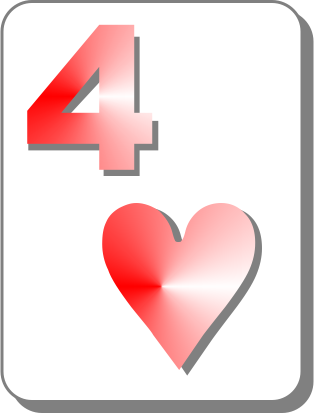
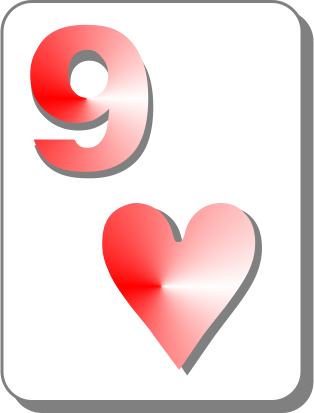

| ↓ Our hand ↓ | ↓ Amy ↓ | ↓ Bob ↓ | ↓ Cal ↓ | ↓ Deb ↓ |
  |
  |
  |
  |
  |
| 5% chance | 13% chance | 4% chance | 1% chance | 77% chance |
Flop comments
Our chances have been cut in half, but we’re still better off with a one in about 20 chance than either Bob or Cal. Amy must hope for a king or two running sevens. Meanwhile Deb has jumped to a 77 percent chance, up from 54.
Show us the turn card…




| ↓ Our hand ↓ | ↓ Amy ↓ | ↓ Bob ↓ | ↓ Cal ↓ | ↓ Deb ↓ |
  |
  |
  |
  |
  |
| 8% chance | 5% chance | 0% chance | 0% chance | 77% chance |
Turn comments
Actually, that card helped us. We now have an 8 percent chance, up from 5 percent. If an eight lands on the river, we’ll hit a straight dead in the middle. There are three eights left among the remaining 38 cards in the deck.
Obviously, we’re in better shape than Bob or Cal. How much better? Well, there’s not a card in the deck that can help either gentleman. They’re toast. So, it’s just our hand against the ladies. Good luck to us!
Number of winning river cards: 3
We’re ready to ride the river…





↑ FLOP ↑ ↑ TURN ↑ ↑ RIVER ↑
| ↓ Our hand ↓ | ↓ Amy ↓ | ↓ Bob ↓ | ↓ Cal ↓ | ↓ Deb ↓ |
  |
  |
  |
  |
  |
| Lost | Lost | Lost | Lost | WON |
Deb won the $5,000,000 pot — a $4,000,000 profit
Our pre-opening results so far: -$1,000,000 in 1 day.
Final poker words
Oh, well. We didn’t expect to win. Deb went wire to wire.
Final real-life words
Some days you can’t quite catch up. That’s okay. Don’t be annoyed. Just wait for your next opportunity.
We’ll try to do better tomorrow. — MC
SHOWDOWN NOTES:
AMY, BOB, CAL, DEB: We play against these same opponents each day. The three-letter names were chosen because they substitute for players A (Amy), B (Bob), C (Cal), and D (Deb).
% CHANCE: The percentages given beneath each players cards are determined by simulation of 1,000,000 deals (5,000,000 individual hands), using Mike Caro’s Poker Probe software. They are rounded to the nearest whole percent, so it’s possible that some could have been very near the mid point and rounded up, when they should have been rounded down, and vice versa. In some cases, the percentages may not add to exactly 100 percent, because of the rounding.
